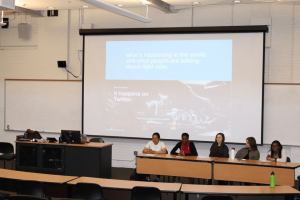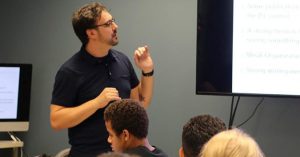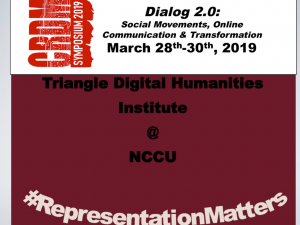Digital Humanities provides new ways to use technology in the production and communication of humanities scholarship. A new English 105i class has been created in the Department of English & Comparative Literature’s Writing Program to help students understand this exciting new field. In the spring of 2019, students in Grant Glass’s 105i: Writing in the Digital Humanities class were able to present papers based on their research at an academic conference at North Carolina State University. And in the fall of 2019, Glass’s 105i: Writing in the Digital Humanities class presented humanities posters at a conference at North Carolina Central University. The abundance of research institutions in the Triangle provides many opportunities for undergraduate students to engage in real world research and communicate that research in a professional academic setting.
English 105i courses introduce students to academic writing within a specific discipline: Business, Natural Science, Health, Social Science, Humanities, Law, or Digital Humanities. These courses help undergraduates develop advanced research and writing skills that focus on adjusting their writing to different audiences, purposes, and mediums. To develop these writing skills, students create research projects th at they can polish for presentation or publication.
at they can polish for presentation or publication.
In the spring of 2019, Glass collaborated with the organizers of the Communication, Rhetoric, and Digital Media Symposium at North Carolina State University to offer his students space to present their work on “#silentsam and the Rhetoric of Protest.” Many scholars in digital humanities utilize social media data as a primary text to better understand social movements. Students in the 105i class analyzed, categorized, and visualized Tweets with the hashtag silentsam from August 20th, 2018, when protesters tore down Silent Sam, a Confederate monument that was located at McCorkle Place on the campus of UNC–Chapel Hill. Using these tweets as data, the students learned how to “close read” the visual and textual information in the Tweets and use quantitative tools like Tableau to learn how Twitter shaped both the on-campus and online protests.
Students created ten-minute presentations on their experience of working with these Tweets by presenting to the class, then to scholars at the CRDM Conference. A range of international scholars attended the two-day symposium in Raleigh, entitled “Dialog 2.0: Social Movements, Online Communication & Transformation.”
Glass asked students to present at NCSU because it provided an opportunity to get real experience at academic conferences. “I think the students step up when you make the stakes real,” said Glass. “Presenting at a conference where other students and scholars ask questions and challenge your ideas helps prepare you for any type of presentation in academia or in the private sector.”
Students used quantitative methodologies to understand larger trends in the data but also used individual Tweets to explore differences between users who had firsthand experiences of the protests and others reacting online. This merging of close and distant reading practices is the hallmark of Digital Humanities methodology.
No two students looked at the exact same Tweets: some traced retweets to certain communities, some looked at other online conversations about confederate monuments, and a few compared news reporting with the experiences of protesters. Despite these differences in analysis, every student learned the skills to balance qualitative and quantitative methodologies and data. Presenting at a real academic conference encouraged students to hone their research, writing, and presentation skills.
Another way students can convey their Digital Humanities research is through an academic poster. Typically, Digital Humanities compose in genres that resemble the natural sciences (like scientific posters) but place a humanistic spin on them. Students in 105i: Writing in the Digital Humanities get a chance to understand and shape this new form of communicating humanistic research.
This semester, another group of students presented posters on their work in Duke University’s Migration Memorial Project to Digital Humanities scholars, librarians, and community members at North Carolina Central University. This conference, titled “#RepresentationMatters”, was held by the North Carolina Digital Humanities Collaborative and is part of the national program of Digital Humanities Institutes sponsored by the National Endowment for the Humanities.
Students categorized and interpreted memorials to different migratory groups by entering them in the online archive. To make the thousands of memorials understandable to the public, the students created virtual “exhibits” bringing together a group of memorials in order to understand how different groups of people are remembered. To reflect on their process and present their findings, students were asked to create academic posters. Rather than creating standard scientific posters, many students crafted new poster designs to communicate their research in a more aesthetically pleasing way.
Glass believes that encouraging students to compose across multiple mediums like online archives and posters allows them to be more creative with their academic writing. “Presenting at these conferences teaches the students about academic conferences, but it also demystifies academic writing and allows students to develop their voices as writers,” said Glass.





